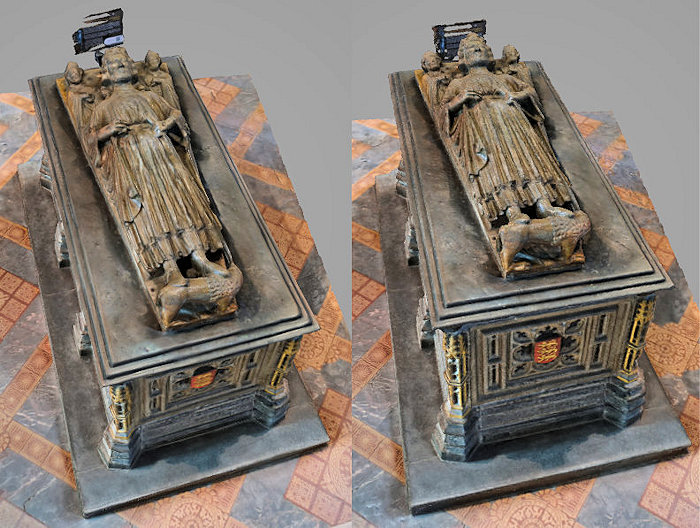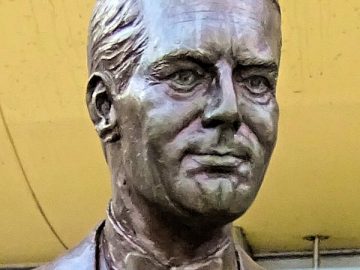To my mind the tomb of King John has to be one of the best medieval memorials in the UK. Dating from around 1232 AD it can be found prominently displayed, as befits a King of England, in the middle of Worcester Cathedral. As you can see below it is a spectacular tomb and well worth visiting. So obviously I decided to make a 3D scan of it but, as is the way with all such scans, I had to decide what photogrammetry app would be best as some are more useful for digital work and some better when we want to make a 3D print (see my previous post about that). But it turns out there is a trick that can let you get a very useful low-poly model, and a very detailed high-poly one, from a single Kiri Engine scan, so I thought I’d share that here.

Quick summary of this 3D creation
Overview: A low-polygon fan-art 3D model of the tomb of King John.
Location: Worcester Cathedral, Worcester, England [map].
Date/era: Medieval, 1232 AD.
Software used: Kiri Engine, Meshmixer, Nomad Sculpt, Blender.
Intended use: Digital only.
Related posts: Effigy of King John, Head of King John.
Download: Sketchfab page (non-commercial license).
If you want to know more about it, the Worcester Cathedral website says the effigy was created in 1232 AD and is considered a fairly accurate representation of the king, the tomb itself being a later addition. King John is notable mainly for his part in the Magna Carta, although you more likely heard of him as the baddie in the Robin Hood stories. That negative image seems likely to be medieval propaganda and he was a pious man who enjoyed spending time at Worcester Cathedral. So, in case you’re mostly interested in history and looking at the 3D model, here it is on Sketchfab (click the play button to load the model and view it in 3D).
However, you may be more interested in the 3D photogrammetry scanning aspect: I made the scan using 189 12-megapixel smartphone photos taken all around the tomb (the paid version of Kiri Engine allows up to 200). I made sure to cover all the angles from down low to up as high as I could reach. Then I uploaded them through the Kiri Engine app with both texture-image and mesh quality parameters set to high. Less than an hour later I then downloaded a zipped textured OBJ file.
Now this is the interesting thing you may have noticed about the app: when you preview the completed scan the 3D model downloads and displays very quickly. That’s because Kiri Engine makes a low-poly model of all your scans and, best of all, it’s included in the download. So I ended up with two 3D models, one being a high-poly version with a whopping 11,810,019 vertices, and a low-poly one with a miniscule 45,000 vertices. The image below shows those models side-by-side and I think there’s very little difference in quality between them for simple digital use.

The main reason the two models both look good, despite the difference in vertex counts, seems to be that Kiri Engine gives the low-poly version a good representation of the shape and the texture image is the same resolution (4096 pixels square) for both (although the low-poly version seems to be a more compressed jpeg to allow for quicker downloading). You can see what I mean in the image below, which shows the sparseness of the low-poly mesh.

Of course, I did want the high-poly version for a reason: I wanted to be able to test using it with Nomad Sculpt, to see how well it would cope with a highly-detailed 3D scan. That’s useful as it’s a very good way to post-process a 3D scan and tidy up blemishes before making a 3D-printable model. So I loaded the high-poly model into Blender first to scale and properly orient it. Then I saved it as a GLTF file and imported it into Nomad Sculpt on my Android tablet. I then voxel-remeshed it with a value of 600, which gave a good compromise between mesh quality and vertex count. As you can see below, the model has plenty of detail and with 519,000 vertices Nomad Sculpt should have little difficulty keeping up with my sculpting.

I was quite happy to find that the low-poly model included in Kiri Engine can be good enough for many 3D digital uses. Obviously I could create a second scan from the images with a low mesh quality setting, or I could decimate the high-poly mesh, but this aspect of Kiri Engine seems much more efficient to me and a bonus from my subscription. But, of course, I’m mostly happy to have made a successful scan of the tomb of King John and I hope you enjoy it too 🙂




